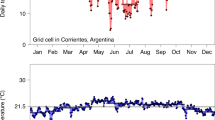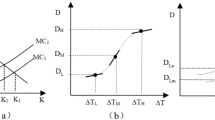Abstract
Increasing evidence shows that global warming has exerted important influence on the economies of societies in the past and will continue to have effects in the future. The provinces of China differ substantially in terms of their temperatures and their degrees of economic development. Therefore, discussion of the positive and negative effects of global warming on economic development at the provincial level is beneficial for determining the effects of global warming on economic development in different provinces, and this discussion also helps to answer the question of how to increase the resilience of economies to global warming. This paper studies the effects of annual average temperature changes on economic growth in the 31 provinces of China from 1978 to 2013 (here referred to as the historical period) and in the 5 typical provinces from 2010 to 2100 (here referred to as the future) under the RCP8.5 scenario. The results indicate that (a) from 1978 to 2013, economic growth exhibits a quadratic nonlinear response to local temperature in all provinces of China and that temperature has both positive and negative effects on the economic growth rates of different provinces. In addition, taking 23.37 °C as a threshold value, over 96% of the provinces display positive effects. (b) Under the RCP8.5 scenario, from 2010 to 2100, although the 5 typical provinces maintain trends reflecting economic growth, the average rate of growth is 80% lower than the value during the historical period. The purpose of this study is to draw the attention of the government to the implications of future global warming for the economic development of different provinces.




Similar content being viewed by others
References
Burke M, Hsiang SM, Miguel E (2015) Global non-linear effect of temperature on economic production. Nature 527(7577):235–239
Chen XG, Yang L (2017) Temperature and industrial output: firm-level evidence from China. J Environ Econ Manag. https://doi.org/10.1016/j.jeem.2017.07.009
Chen S, Chen X, Xu J (2016) Impacts of climate change on agriculture: evidence from China. J Environ Econ Manag 76(8):105–124
EC-SCNARCC (2015) The third national assessment report on climate change. Science Press, Beijing, pp 1–108
Fisher AC, Hanemann WM, Roberts MJ, Schlenker W (2012) The economic impacts of climate change: evidence from agricultural output and random fluctuations in weather: comment. Am Econ Rev 102(7):3749–3760
Gable FJ (1997) Climate change impacts on caribbean coastal areas and tourism. J Coast Res 27(SPECIAL):49–69
Hsiang S, Kopp R, Jina A, Rising J, Delgado M, Mohan S, Rasmussen DJ, Muir-Wood R, Wilson P, Oppenheimer M, Larsen K, Houser T (2017) Estimating economic damage from climate change in the United States. Science 356(6345):1362–1369
Huang DL, Li XM, Ju SP (2015) Climate change affecting grain production, consumption and economic growth in China: based on the agricultural CGE model. Chin Agric Sci Bull 32(20):165–176 (in Chinese)
IPCC (2007) Climate change 2007: the physical science basis. Contribution of Working Group I to the Fourth Assessment Report of the Intergovernmental Panel on Climate Change. Cambridge University Press, Cambridge
IPCC (2013) Climate change 2013: the physical science basis. Contribution of Working Group I to the Fifth Assessment Report of the Intergovernmental Panel on Climate Change. Cambridge University Press, Cambridge
Kimball BA (1982) Carbon dioxide and agricultural yield: an assemblage and analysis of 430 prior observations. Agron J 75(5):779–788
Li C, Qiu J, Frolking S, Xiao X, Salas W, Moore B, Boles S, Huang Y, Sass R (2002) Reduced methane emissions from large-scale changes in water management of China’s rice paddies during 1980–2000. Geophys Res Lett 29(20):31–33
Liu YJ, Lin ED (2007) Effects of climate change on agriculture in different regions of China. Adv Clim Chang Res 3(4):229–233 (in Chinese)
Riahi K, Grübler A, Nakicenovic N (2007) Scenarios of long-term socio-economic and environmental development under climate stabilization. Technol Forecast Soc 74(7):887–935
Riahi K, Rao S, Krey V, Cho C, Chirkov V, Fischer G, Kindermann GE, Nakicenovic N, Rafaj P (2011) Rcp 8.5—a scenario of comparatively high greenhouse gas emissions. Clim Chang 109(1–2):33–57
Rogelj J, Den EM, Hã¶hne N, Fransen T, Fekete H, Winkler H, Schaeffer R, Sha F, Riahi K, Meinshausen M (2016) Paris agreement climate proposals need a boost to keep warming well below 2â°c. Nature 534(7609):631–639
Schlenker W, Roberts MJ (2009) Nonlinear temperature effects indicate severe damages to U.S. crop yields under climate change. Proc Natl Acad Sci USA 106(37):15594–15598
Tao F (2012) Response of crop yields to climate trends since 1980 in China. Clim Res 54(3):233–247
Wang L, Huo ZG, Zhang L, Jiang YY, Xiao JJ, Lu XF (2012) Effects of climate change on the occurrence of crop diseases in China. Chin J Ecol 31(7):1673–1684 (in Chinese)
Zhang L, Huo ZG, Wang L, Jiang YY (2012) Effects of climate change on the occurrence of crop insect pests in China. Chin J Ecol 31(6):1499–1507 (in Chinese)
Zivin JG, Neidell M (2014) Temperature and the allocation of time: implications for climate change. J Labor Econ 32(1):1–26
Funding
This work was supported by the National Key Research and Development Program—Global Change Mitigation Project: Global change risk of population and economic system: mechanism and assessment (No. 2016YFA0602403); the Beijing Municipal Natural Science Foundation (No. 9172010); the National Natural Science Foundation of China (No. 41775103); and the National Basic Research Program of China (973 Program)—Global change and environmental risk’s evolution process and its integrated assessment model (No. 2012CB955402).
Author information
Authors and Affiliations
Corresponding author
Additional information
Publisher’s note
Springer Nature remains neutral with regard to jurisdictional claims in published maps and institutional affiliations.
Rights and permissions
About this article
Cite this article
Li, N., Bai, K., Zhang, Z. et al. The nonlinear relationship between temperature changes and economic development for individual provinces in China. Theor Appl Climatol 137, 2477–2486 (2019). https://doi.org/10.1007/s00704-018-2744-6
Received:
Accepted:
Published:
Issue Date:
DOI: https://doi.org/10.1007/s00704-018-2744-6




